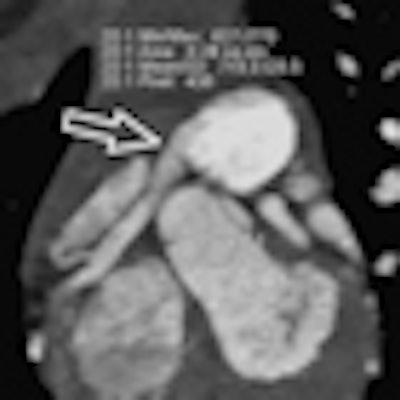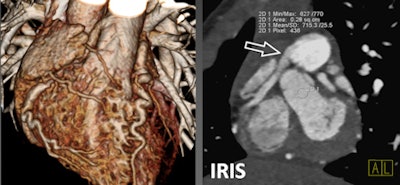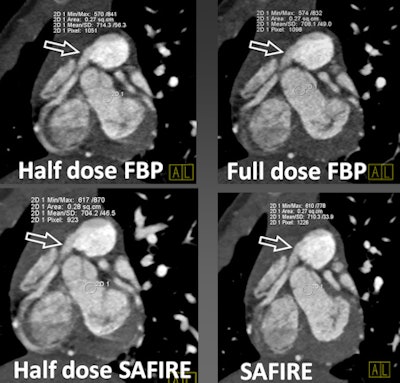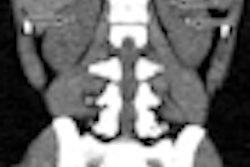
SAN FRANCISCO - Iterative reconstruction techniques (IRT) can dramatically reduce radiation dose for pediatric CT without compromising image quality, according to a pair of presentations on Monday at the International Society for Computed Tomography (ISCT) annual meeting.
Dr. Joseph Schoepf, from the Medical University of South Carolina, shared study data with session attendees that demonstrated how IRT could lower dose by up to 50%. The technique improved image noise, signal-to-noise ratio, contrast-to-noise ratio, and subjective image quality compared to filtered back projection (FBP) in low-radiation dose pediatric CT angiography. In another talk, Dr. Dianna Bardo, of Oregon Health and Science University, shared how IRT decreased pediatric CT dose by 40%.
"How do we deal with radiation dose in pediatric imaging? We need to adjust imaging acquisition protocols to the particular needs of children, and we can do that by using iterative reconstruction techniques," Schoepf said.
Schoepf's study included 40 pediatric patients ranging in age from newborn to teenager. Half of the patients underwent nonelectrocardiography (ECG)-gated imaging and the other half underwent ECG-gated imaging. Schoepf's team used five different reconstruction series for the images:
- Full-dose FBP reconstructions
- Half-dose datasets reconstructed with FBP
- Iterative reconstruction in image space (IRIS)
- Full-dose sonogram affirmed iterative reconstructions (SAFIRE)
- Half-dose datasets reconstructed with SAFIRE
The study showed that image noise with IRIS and full-dose SAFIRE was lower than with FBP, while signal-to-noise ratio and contrast-to-noise ratio were higher. The researchers also found that image noise was lower and signal-to-noise ratio and contrast-to-noise ratio were higher in ECG-synchronized half-dose SAFIRE studies as compared with full-dose FBP studies. Image quality scores were higher for IRIS, full-dose SAFIRE, and half-dose SAFIRE than for full-dose FBP.
 |
| Above, 4-year-old boy with ARCAPA, or anomalous orgin of the right coronary artery from the pulmonary artery. All images courtesy of Dr. Joseph Schoepf. |
 |
| Iterative reconstruction series. |
Schoepf's group calculated radiation dose using pediatric-specific conversion factors, and found that dose for non-ECG gated studies was 0.4 ± 0.4 mSv and dose for ECG-gated studies was 1.4 ± 1.2 mSv. Effective radiation dose equivalent associated with half-dose SAFIRE acquisitions measured 0.7 ± 0.6 mSv, which is quite promising for pediatric CT, Schoepf told session attendees.
"What was encouraging about our results was that despite using 50% less radiation, we still ended up with better noise characteristics and better subjective image quality with [the iterative reconstruction techniques]," he said.
In a related presentation, Dr. Dianna Bardo described how her department lowered pediatric MDCT doses by implementing IRT. Following an initial evaluation of IRT image quality, the department instituted a 40% dose reduction for pediatric neck, spine, chest, abdomen, pelvis, and musculoskeletal exams, Bardo said. Images were reconstructed using blends of filtered back projection and IRT.
"We had reluctant participants in reading IRT images, for various reasons," Bardo told session attendees. "Some felt IRT images were too different, others said that it wasn't a good idea to lower the dose anymore for fear of missing lesions. My favorite was the resident who told me IRT images aren't 'real.' "
But Bardo's department found that mean effective dose and CT dose index volume (CTDIvol) were 60% lower in reduced-dose CTs performed with the FBP/IRT blend, compared with controls performed with standard low-dose pediatric protocols and FBP reconstruction. In addition, the department achieved submillisievert effective doses in 60% of the FBP/IRT blend exams, compared with 2% of standard-dose FBP exams, she said.
"Using IRT to enable reduced dose parameters -- in addition to traditional dose-lowering strategies -- allows for submillisievert effective radiation doses for MDCT, without loss of diagnostic image quality," Bardo concluded.



















